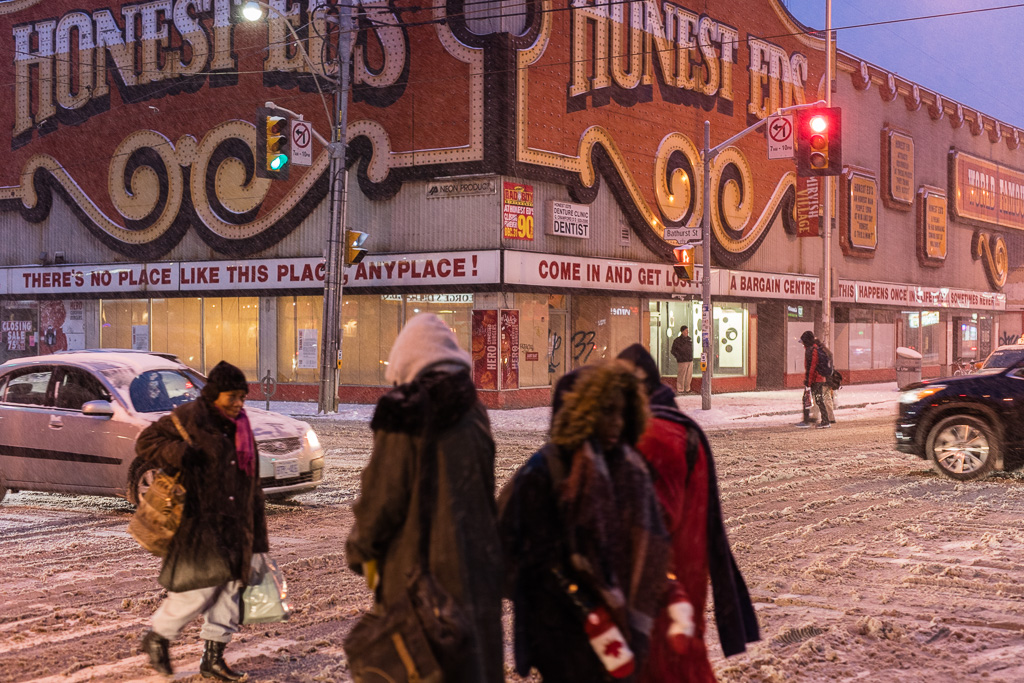I’ve devoted the month of May to images that suggest ephemeral concerns, so it’s natural to suppose that when I present an image of an iconic Toronto landmark, now demolished, you might suppose I’m waxing nostalgic for a place I miss. It’s true. I miss the famous discount department store founded by Ed Mirvish. I miss the vibe it brought to the neighbourhood. I miss how it stood as an acknowledgement of the people who live here. The real people. The immigrants and students. It was absolutely analog. It resisted slick branding and social media campaigns. Sometimes that meant it was tacky as all shit. But, hey, if polished international brands are what you’re after, walk a kilometre east to the mink mile for your Gucci handbags and your Rolex watches.
But I’m not an overly nostalgic person. I’m more concerned with what’s in front of me than with what lies behind. In the case of Honest Eds, what lies in front is what towers overhead. Westbank and The Peterson Group purchased the site in 2014 and while they acknowledge the history of Mirvish Village and will include signs of that history in their new development, it is after all one more of countless residential/commercial developments popping up like mushrooms all over the city.
Toronto is a boom town. That boom started with the first Québec referendum when Montreal businesses, most notably financial institutions, fled the province for Toronto. It got a boost during the 2008 financial crisis when the world discovered that Canada’s more tightly regulated financial institutions, now all located in Toronto, had little exposure to dodgy credit instruments and so had weathered the storm relatively unscathed. More than ever, Toronto became an attractive place to park capital. Among other things, that influx of capital translated into new condo starts so that, by 2012, there were 148 cranes operating in the city. That pace has only accelerated. In 2021, there were 208 cranes operating in Toronto, almost as many as the combined total (276) of the other 14 North American cities in the survey.
Apart from the chaos of perpetual construction and infrastructure that can’t keep pace, the big downside of living in a skyscraper nursery is that all the buildings start to look the same. I find myself walking down a new condo canyon, all the familiar landmarks obliterated, and I can’t tell where I am anymore. I could be on one street. I could be on another street. Who knows? They all look the same to me.
I commend a short article by Aaron Betsky, “The Case for a New International Style.” He notes the trend to generic design in contemporary architecture influenced “by global flows of finance and culture, as well as by similarities in methods of production and standards”. While the influence of safety concerns arising from the pandemic has yet to play out in large projects, Betsky calls on the building industry to resist the temptation to what he calls “relentless value engineering”.
A word that comes to mind is “sterility.” While this word suggests a positive value in the context of health care and epidemiology with clean surfaces and filtered air, as an aesthetic value, it is soul deadening. I fear that much of Toronto’s built space is sterile in this latter sense. What I miss most about the demolition of Honest Eds is the way it disrupted urban space. It was the opposite of sterile.

One reply on “Honest Eds”
[…] are less stable in times of crisis. But Toronto is not one of those cities. Say what you will about all the condominiums sprouting like mushrooms, these projects guarantee that the city’s core enjoys a vibrant street life which in turn […]